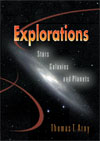Our home planet is separated from other astronomical bodies by such vast distances
that, with few exceptions, we cannot learn about them by direct measurements
of their properties. For example, if we want to know how hot the Sun is, we
cannot stick a thermometer into it. Similarly, we cannot directly sample the
composition of the atmosphere of Saturn or a distant star. However, we can sample
such remote bodies indirectly by analyzing their light. Light from a distant
star or planet can tell us what the body is made of, its temperature, and many
of its other properties. Light, therefore, is our key to studying the Universe.
To use the key, however, we need to understand some of its properties. In this chapter, we will discover that light is a form of energy that can be
thought of either as a wave or as a stream of particles. Furthermore, we will
discover that the light we see is just part of the radiation emitted by astronomical
objects. We will also learn that light can be produced within an atom by changes
in its electrons' energies. These changes imprint on the light the atom's "signature".
However, the light may also bear unwanted messages. For example, when light
reaches our atmosphere, gases there alter its properties, blocking some rays,
and bending and blurring others. These distortions place severe limits on what
astronomers can learn from the ground. The goal of this chapter is to explain the nature of light, how it is produced,
and how it interacts with our atmosphere. Our first step toward this goal is
to better understand what light is. |



 2002 McGraw-Hill Higher Education
2002 McGraw-Hill Higher Education